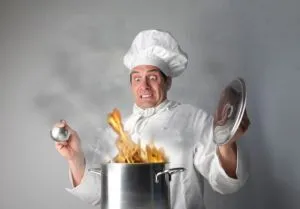Few things are as disappointing as going through the effort to make a nice meal only to have it turn out soggy, burnt, or inedible. Most of the time, these results are from common cooking mistakes that can be avoided.
Let’s take a look at some of them one at a time.
Overcrowding
Without a doubt, the most common cooking blunder is overcrowding. You set out to make a meal, packing all the chicken tightly into a skillet, or all the vegetables jam-packed into a casserole dish, only to find they are bland and soggy in the end.
During the cooking process, moisture is naturally released from the food. Piling food too close together in a pan traps that moisture beneath the food, where it forms a pool. The food will cook, but the water trapped underneath cannot escape in the form of steam. In the end, your food will be soggy and unable to caramelize, where it could form a delicious crust.
The same holds true for baked goods. Don’t jam pack a dozen of your favorite healthy, gluten-free cookies on a cookie sheet where they will glob together in a horrible mess. Spread them out so they can grow and rise as they were intended.
By leaving space between pieces, you can get the circulation of heat and air, which develops the color and flavor, and locks in moisture. If cooking in separate batches, the first can be kept warm in a container with tented foil or a low-temperature oven.
Using a pot that’s too small
If you’re wondering why your gluten-free pasta always comes out in a sticky clump, chances are you’re using a pot that is too small. Adding pasta to a smaller container of water results in the temperature of the water being lowered substantially, compared to a larger volume of water. It will take longer for it to get back up to boiling temperature. In the meantime, your pasta will be clumped together in the bottom of the pan.
Instead, use a large pot of water and make sure it is at a rapid boil stage. Tossing in 2 tablespoons of salt when you add the pasta can help as well. Don’t forget to stir frequently to help separate the noodles.
Cooking cold
Ever found yourself frustrated with sauteed vegetables that are stuck to the bottom of the pan, even though you had oil in there? When you have heated oil and a hot pan it makes for a nonstick surface. However, if you don’t give either time to warm up and just toss in the food, it will likely stick to the bottom.
Instead allow one to two minutes with the heat on to warm up your empty pan. If you hold your hand three to four inches above the pan surface and can feel the heat, then it is ready. Add your oil at that time, and give it a minute or two to heat up.
Nonstick pans can release fumes if they sit over heat for too long while empty. So, be sure to add oil right away if you use a nonstick surface pan. However, as these pans have been associated with health risks, consider switching to safer alternatives.
Damaging knives with the dishwasher

These good knives should be treated with care and washed by hand. Always keep the blade facing away from you, and hold the handle as you wipe them clean. Do not leave them to dry on a rack as this can cause discoloration. Instead, they should be dried immediately and put away.
By avoiding these kitchen blunders, you can start to see a lot more success from your meals!
-The Alternative Daily
Sources:
http://www.huffingtonpost.com/2015/01/28/overcrowding-cooking-mist_n_6551098.html?cps=gravity_2246_3513081417136515900
http://www.realsimple.com/food-recipes/cooking-tips-techniques/basic-cooking
http://www.ehow.com/info_8067025_tips-cooking-stainless-steel-cookware.html
http://www.today.com/id/35988894/ns/today-today_food/t/most-common-cooking-mistakes/#.VNka-PnF8pg
